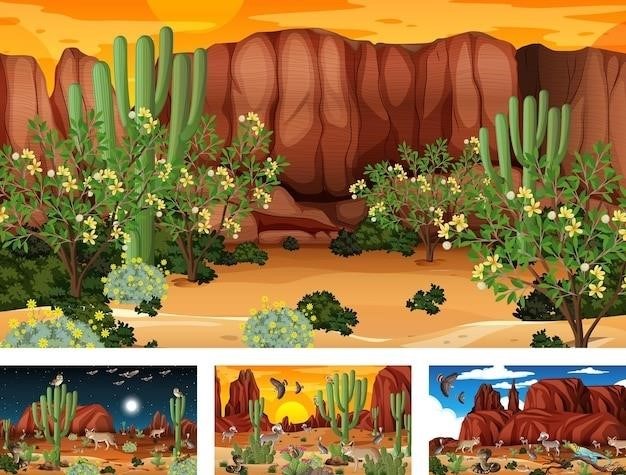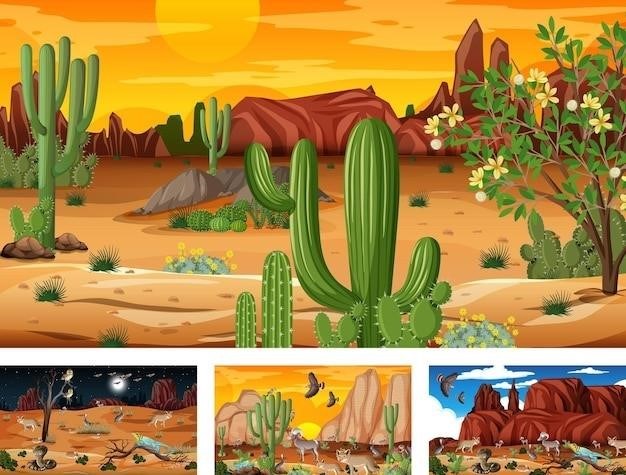Landscape Plants for the Arizona Desert⁚ A Comprehensive Guide
This guide explores diverse desert-adapted plants ideal for Arizona landscaping. Discover low-water-use options, native species enhancing biodiversity, and xeriscaping techniques for water conservation. Learn about choosing the right plants, designing thriving gardens, and proper plant care.
Choosing the Right Plants for Your Desert Landscape
Selecting appropriate plants is crucial for a successful Arizona desert landscape. Consider factors like sun exposure, soil type, and water availability. Native Arizona plants, such as the hardy Apache Plume (Fallugia paradoxa) or the vibrant Angelita Daisy, often thrive with minimal intervention. However, many non-native drought-tolerant species also excel, offering a wide array of colors, textures, and sizes. Research individual plant needs before purchasing; some require more frequent watering than others, even within the “low-water” category. Assess your property’s specific conditions—full sun, partial shade, rocky soil, or clay—to ensure plant compatibility. Consult resources like the “Pink Book” (Landscape Plants for the Arizona Desert) for detailed information on hundreds of suitable species. This guide provides valuable insights into mature size, water needs, and ideal growing conditions for each plant, ensuring informed choices that contribute to a beautiful and sustainable landscape.
Low-Water-Use Plants⁚ A Key to Desert Landscaping
Conserving water is paramount in Arizona’s arid climate, making low-water-use plants essential for sustainable landscaping. These plants, categorized as xeric, are naturally adapted to survive with minimal irrigation. Many native species fall into this category, requiring infrequent watering once established. The “Pink Book,” Landscape Plants for the Arizona Desert, is an invaluable resource, detailing water requirements for numerous species. Choosing plants with appropriate water needs prevents overwatering, a common issue leading to plant stress and disease. Consider grouping plants with similar water requirements to streamline irrigation. Remember, even low-water plants benefit from occasional deep watering, especially during extended dry spells. This ensures healthy root development and promotes overall plant vigor. Prioritize selecting plants suited to your specific microclimate and soil conditions for optimal results. This approach combines aesthetic appeal with responsible water management.
Native Arizona Plants⁚ Enhancing Biodiversity and Sustainability
Incorporating native Arizona plants into your landscape offers significant ecological and aesthetic advantages. These plants are naturally adapted to the local climate, soil, and rainfall patterns, requiring less water and maintenance than non-native species. Choosing native plants supports local biodiversity by providing habitat and food sources for native insects, birds, and other wildlife. This contributes to a healthier and more balanced ecosystem. Many native options offer attractive blooms and foliage, adding visual interest to your garden. Resources like the Landscape Plants for the Arizona Desert guide provide detailed information on various native species, their growth habits, and water requirements. By selecting a diverse range of native plants, you can create a vibrant and sustainable landscape that thrives with minimal intervention. This approach reduces reliance on supplemental irrigation and minimizes the need for chemical fertilizers or pesticides, further promoting environmental stewardship.
Xeriscaping Techniques⁚ Optimizing Water Conservation
Xeriscaping, a landscaping approach emphasizing water conservation, is particularly well-suited for the Arizona desert. Key techniques include careful plant selection, focusing on drought-tolerant species native to arid regions. Efficient irrigation systems, such as drip irrigation or soaker hoses, deliver water directly to plant roots, minimizing evaporation. Mulching helps retain soil moisture and suppress weeds, reducing the need for frequent watering. Proper soil preparation, ensuring good drainage and aeration, promotes healthy root growth and reduces water stress on plants. Strategic grouping of plants with similar water needs simplifies irrigation management. Consider incorporating hardscaping elements like pathways and patios, reducing the overall area requiring irrigation. Careful planning and design are crucial for successful xeriscaping, creating a visually appealing and water-wise landscape. The Landscape Plants for the Arizona Desert guide offers valuable insights into plant choices and implementation strategies for effective xeriscaping.
Designing a Thriving Desert Garden⁚ Tips and Tricks
Creating a vibrant desert garden requires thoughtful planning and consideration of the unique challenges of the Arizona climate. Begin by analyzing your site’s conditions, including sunlight exposure, soil type, and drainage. Select plants appropriate for these conditions, considering their mature size and spacing requirements to avoid overcrowding. Group plants with similar water needs together to simplify irrigation management. Incorporate a variety of textures, colors, and heights to create visual interest and depth; Consider using hardscaping elements such as rocks, gravel, or pathways to complement the plantings and reduce the area needing irrigation. Remember that proper soil preparation is crucial; amend the soil with organic matter to improve drainage and water retention. Regular maintenance, including weeding and pruning, will keep your garden healthy and thriving. Utilize mulching to conserve moisture and suppress weeds. By following these guidelines and referencing resources like the “Landscape Plants for the Arizona Desert” guide, you can cultivate a beautiful and sustainable desert garden that flourishes in the Arizona sun.
Maintaining Your Desert Landscape⁚ Pruning and Care
Maintaining a healthy desert landscape involves a different approach than traditional gardening. Over-pruning is detrimental to desert plants, often stressing them and reducing flowering. Focus instead on selective pruning to remove dead, damaged, or diseased branches. The best time to prune most desert plants is after they finish flowering, avoiding stress during the growing season. For specific pruning needs, consult resources like the “Landscape Plants for the Arizona Desert” guide or contact your local agricultural extension office. Regular weeding is essential to prevent competition for water and nutrients. Mulching helps retain soil moisture and suppress weed growth. Appropriate irrigation is crucial; avoid overwatering, which can lead to root rot. Deep, infrequent watering encourages deep root growth, making plants more drought-tolerant. Monitor your plants regularly for signs of pests or diseases. Early detection allows for prompt treatment, preventing widespread damage. Consider using organic pest control methods whenever possible. By following these guidelines, you can ensure your desert landscape remains healthy, beautiful, and water-wise for years to come.

Resources for Arizona Desert Landscaping⁚ Books and Guides

Numerous resources are available to assist in successful Arizona desert landscaping. The highly regarded “Landscape Plants for the Arizona Desert,” often called “The Pink Book,” published by the Arizona Municipal Water Users Association (AMWUA), provides comprehensive information on over 200 low-water-use plants. This guide is available as a PDF download from the AMWUA website or through local conservation offices. Other valuable resources include publications from the University of Arizona Cooperative Extension, offering detailed guides on various aspects of desert gardening, including plant selection, water conservation techniques, and pest management; Local nurseries often stock books and guides specific to the Arizona desert environment, providing practical advice on plant care and landscape design. Online resources such as the AMWUA website and various gardening blogs offer additional information, articles, and forums where you can connect with experienced desert gardeners. Remember to check with your local library as well; they frequently have an extensive collection of books on desert landscaping and native plants. By utilizing these diverse resources, you can create a thriving and sustainable desert landscape.
The “Pink Book”⁚ Landscape Plants for the Arizona Desert PDF
The “Pink Book,” officially titled “Landscape Plants for the Arizona Desert,” is a seminal resource for anyone undertaking desert landscaping in Arizona. Published by the Arizona Municipal Water Users Association (AMWUA), this comprehensive guide offers detailed information on a wide array of plants suitable for the arid climate. Its user-friendly format includes photographs and descriptions of over 200 low-water-use plants, making plant selection straightforward. The “Pink Book” goes beyond simple plant listings; it provides valuable insights into xeriscaping techniques, water conservation strategies, and sustainable gardening practices. The PDF version offers easy access and searchability, allowing users to quickly find information on specific plants or landscaping challenges. While the online PDF version is readily available, printed copies can be obtained through local conservation offices. The “Pink Book” is an invaluable tool for both novice and experienced desert gardeners, providing the knowledge and resources needed to create a beautiful and water-wise landscape. Its enduring popularity stems from its practical advice and comprehensive coverage of desert-adapted plants.
Utilizing Native Shrubs and Trees in Your Design
Incorporating native Arizona shrubs and trees offers significant advantages in desert landscaping. These plants are naturally adapted to the region’s harsh conditions, requiring minimal water and maintenance once established. Their resilience contributes to a sustainable and environmentally friendly landscape. Native species like the Palo Verde tree, with its vibrant yellow flowers and striking form, provides both visual interest and shade. Desert Willow, known for its beautiful pink or purple blooms, adds a splash of color. For smaller spaces, consider native shrubs such as Apache Plume, with its delicate white flowers, or brittlebush, offering bright yellow blossoms. These plants support local ecosystems by providing habitats for native birds and insects, contributing to biodiversity. Utilizing native plants reduces the need for chemical fertilizers and pesticides, promoting a healthier environment. Choosing appropriate native species based on sun exposure, soil type, and desired size ensures their success. Resources like the “Pink Book” (Landscape Plants for the Arizona Desert) provide detailed information to guide plant selection and placement, ensuring a thriving and aesthetically pleasing native plant landscape.
Incorporating Cacti and Succulents for Unique Aesthetics
Cacti and succulents are iconic elements of the Arizona desert landscape, offering a unique aesthetic appeal and remarkable drought tolerance. Their diverse forms, textures, and colors add visual interest to any desert garden. From the towering saguaro cactus, a symbol of the Sonoran Desert, to the smaller, more compact prickly pear varieties, a wide range of choices exists to suit different design styles and space constraints. Succulents, with their fleshy leaves and diverse shapes, provide textural contrasts and vibrant colors. Consider incorporating a variety of sizes and forms to create depth and visual intrigue. Placement is crucial; position sun-loving varieties in full sun and those preferring partial shade accordingly. Careful consideration of mature size is also essential to avoid overcrowding. Remember that many cacti and succulents have spines or thorns, requiring careful handling and placement to ensure safety. Resources such as the AMWUA’s “Landscape Plants for the Arizona Desert” guide offer detailed information on specific species, their care requirements, and suitability for various landscape designs. By carefully selecting and placing cacti and succulents, you can create a striking and low-maintenance desert garden that showcases the unique beauty of these remarkable plants.
Successful Desert Landscaping⁚ Case Studies and Examples
Examining successful desert landscapes offers valuable insights for planning your own project. The AMWUA’s “Landscape Plants for the Arizona Desert” PDF, along with other online resources, showcases diverse examples. Observe how different plant combinations create visually appealing and water-wise gardens. Note the effective use of hardscaping, such as pathways and patios, to complement the planting schemes. Analyze how various design elements, including rock gardens, gravel mulches, and strategically placed boulders, contribute to the overall aesthetic and functionality. Consider the integration of native plants to enhance biodiversity and attract local wildlife. Successful case studies highlight the importance of proper plant spacing and irrigation techniques to ensure healthy growth. Analyze how different species are grouped together to maximize visual impact and create microclimates. Pay close attention to the use of color, texture, and form in creating a harmonious and visually interesting landscape. Studying these examples allows you to adapt successful strategies to your unique site conditions and design preferences, ultimately leading to a thriving and sustainable desert garden that conserves water and showcases the beauty of the desert environment. Remember, the “Pink Book” and other resources are invaluable tools for researching specific plant choices and design approaches.
